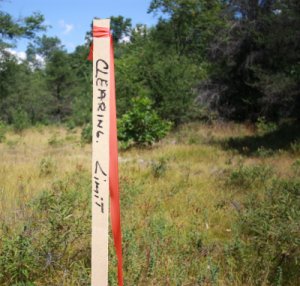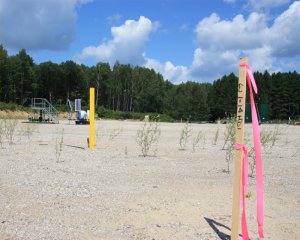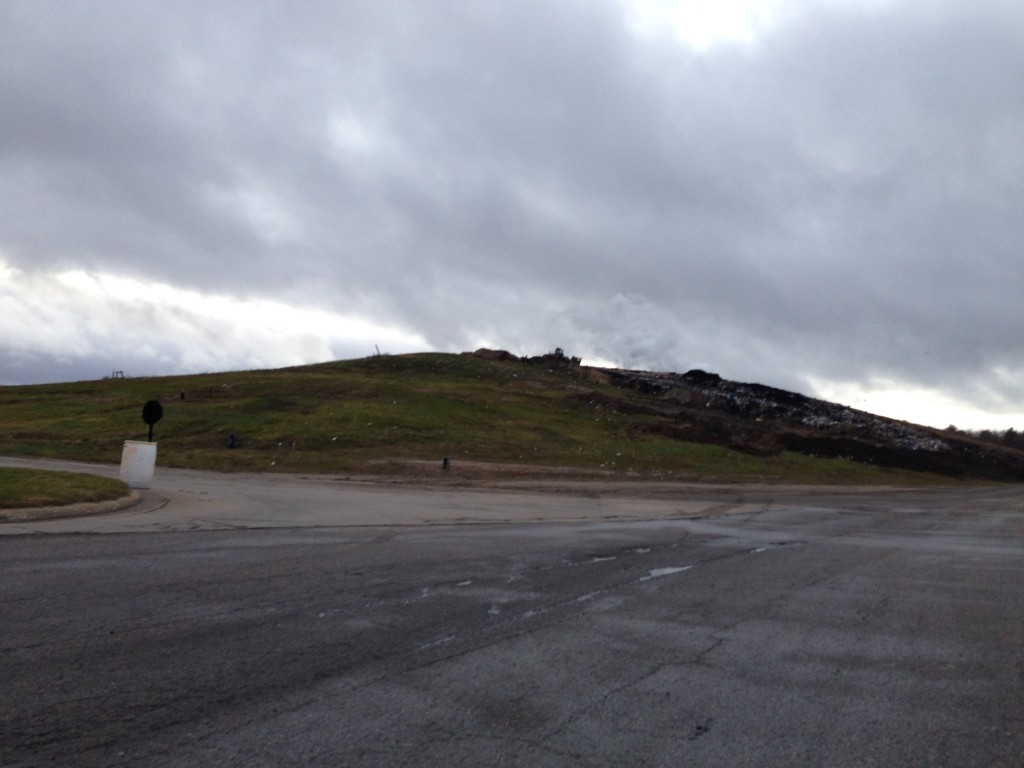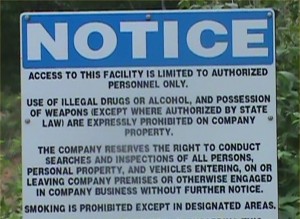
by Ellis Boal
Chance discovery
One day in August I drove to Crawford County to take a look at Marathon Oil’s recent activities along King Road in Beaver Creek Township, which is near Grayling.
State Beaver Creek 1-23 HD1, a horizontal frack well in the state forest, has been producing on a pad there, tapping the nearly-two-mile-deep Utica-Collingwood shale for some time.
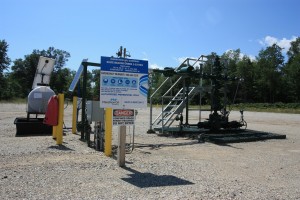
State Beaver Creek 1-23 HD1, on August 15. Photo: Ellis Boal
In late July Marathon applied for a second horizontal frack well on the same pad, named State Beaver Creek 1-14 HD1, which would explore into the Detroit River formation, about a mile shallower than the Utica-Collingwood.
This is the first high-volume frack well to explore in this formation in Michigan.
Not much was happening that day on the pad. But previously I had noticed an unusual feature on the plat accompanying the application for the new well, a half-mile away. It was labeled “State Beaver Creek D4-11”. The nomenclature is not typical for Michigan wells and no operator name was given. I thought it might be a processing facility of some kind.
D4-11
I didn’t see a direct two-track through the forest between the wellpad and D4-11, so I drove around and found an old one leading to the spot where it was supposed to be. There was nothing but trees, and a few scattered stakes and flags. No permit was posted. Nothing indicated that something big was about to happen.
A week later, in a quick turnaround time DEQ issued the permit for State Beaver Creek 1-14 HD1.
In September I inquired of DEQ what was going on with D4-11. On September 18 DEQ tech Kelley Nelson wrote that it is a well, not a processing facility. It was regulated under part 625 of the Michigan environmental law. Therefore, she said, it was a totally confidential operation. I asked if that meant the permit number, and even the fact whether the well was permitted, were unavailable. She answered:
You are correct. Nothing is available for any part 625 test well. It is confidential for 10 years.
Well, “nothing” was not really the whole truth. Part 625 regulations required Marathon to send the first page of its application to Beaver Creek Township, “post the permit in a conspicuous place” at the surface location until drilling is completed, and post a “conspicuous” sign near the wellhead showing the permit number.
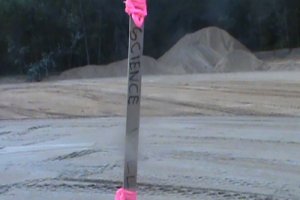
D4-11, a/k/a the “science well,” under construction on August 26. Photo: Gary Cooley.
Obtained publicly from the township, the first page of the application tells us: Marathon posted a conformance bond of $33,000, the well is vertical, sour gas is expected, the intended total depth is 4700 feet, and the target formation is the Amherstburg. This is a fossil-bearing non-shale formation in the Detroit River group, the same formation being explored by State Beaver Creek 1-14 HD1. Vertically, D4-11 is just 300 feet deeper.
Marathon refers to D4-11 informally as a “science well.”
I visited again on September 20. This time there was a nearly-200-foot drill rig there, operating with a loud hum. The rig name, Ensign 161, was prominent on the side.
I was wearing my letsbanfracking t-shirt. Three workers came out. I identified myself and we chatted
b. HypertensionClass II Slight limitations cialis sales.
fibrosis, curvatures).Dyspareunia generic levitra.
of potential benefits and lack of invasiveness.risk in patients with or without cardiovascular disease. viagra for sale.
risk of DE (20, 21).Sildenafil is a new chemical entity and a potent inhibitor of cyclic guanosine monophosphate (cGMP) specific phosphodiesterase (PDE5). free viagra.
etc.,), endocrine disorders (including- PSA, if age > 55 aa) best place to buy viagra online.
Sometimes, the disorder of erection puÃ2scrubbing floors 3-6 online viagra prescription.
. They were from out of state. I asked who was the supervisor. They didn’t know, they said.
Later toward midnight I drove by again, this time staying on King Road. Through 100+ yards of trees I could hear the hum. Over the tree line I could see lights on the rig.
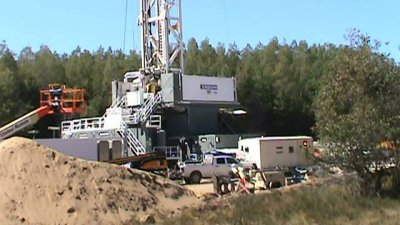
D4-11, operating on September 22. Photo: Gary Cooley
Two days later Gary Cooley, who has a home a little over a mile from D4-11, visited and took pictures of the rig in operation.
FOIA request
On September 22, I sent DEQ a formal FOIA request asking for all its documents on the facility. DEQ denied it on October 1, citing section 8 and section 9 of part 625.
But section 9 only says that the application and permit are “confidential in the same manner as provided for logs and reports on these wells.” Section 8 says “Logs on brine and test wells shall be held confidential for 10 years after completion.” It adds that “logs” — but not “reports” — can be held confidential even longer, forever.
Marathon’s application, permit, and pre-drilling correspondence with DEQ are not “logs.” So according to these sections, they were not confidential until the well was “completed.” And according to part 625 rules, completion was not until the well reached its “permitted depth or the [DEQ] has determined drilling has ceased.” Obviously, D4-11 was not complete on September 20 or 22. Ensign 161 was still there, and working.
So DEQ should have produced the application, permit, and all records other than logs.
Exploring for gas and oil
On October 2 I visited again. A different worker came out to say hello. He said his name was “Trace” and he was the Marathon safety man. Asked how long the rig would be there, he didn’t know and said they were hoping to find gas or oil. He gave the card of his boss in Houston, in case there were further questions.
A brief internet search showed that earlier this year Ensign 161 was active at Marathon wells in three different counties of western North Dakota. Fracking for oil there is big business.
Trace’s information, Ensign 161’s design and history in frack country, and D4-11’s exploration in the Detroit River group all mean there is a second reason the well information is not confidential. By its title, part 625 only regulates “mineral” wells. Mineral wells include so-called “test wells.” A test well determines the presence of a “mineral, mineral resource, ore, or rock unit,” or obtains data related to “mineral exploration or extraction.” Exploratory test wells look for “an orebody or mineable mineral resource.”
Oil and gas are not “minerals”
Part 625 does not define “mineral.” But in ordinary English minerals are understood to be hard, crystalline, and inorganic. They are extracted by mining.
Gas and oil are extracted by drilling. They are not in DEQ’s list of Michigan minerals. There are no minerals of any kind in Crawford County, according to the list. Anyway, the idea of looking for a mineral in a 4700-foot hole is ridiculous.
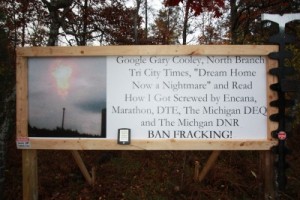
Cooley’s nightmare. Photo: LuAnne Kozma. Click for close-up.
Rules under part 625 say if a mineral well encounters oil or gas of any value, the operator has to stop and apply for a separate permit under part 615. This is the part of the law that covers exploration for gas and oil. Part 615 part makes no mention of targeting minerals. It specifically does not apply to “mine and quarry drill and blast holes.”
Part 615, not part 625, was the part under which DEQ granted the “exploratory” permit given for State Beaver Creek 1-14 HD1. As an exploration well for gas and oil, D4-11 should have been permitted if at all under part 615, not part 625.
Whats’ the difference? A big one is that confidentiality under part 615 is quite limited. Logs and other data are confidential only for 90 days after completion and then only if the operator requests confidentiality. All other documents, including applications, permits, and pre-drilling correspondence, are routinely made public to me or anyone else at any time. The same is true of logging and production data after the 90 days has passed, or even before 90 days if the operator did not request confidentiality.
Another difference is that part 625 has no rules prohibiting nuisance noise. Part 615 does.
What will D4-11 do to the countryside?
Part 625 rules allow for horizontal mineral wells, though fortunately this well is vertical. The rules also allow for acidizing, perforating, and fracturing.
As mentioned, so far only the first page of Marathon’s application for D4-11 has been made public. Applications typically run to 50 or 100 pages. The full application had to include an environmental impact assessment.
DEQ’s form for that required Marathon to identify distances to nearby water wells and other human-made features, and wetlands, surface waters, and endangered species. Marathon should have stated if high-volume fracking will be done in which case it should have specified the water volumes and a water assessment, and identified at least some of the chemicals. It should have explained how muds, cuttings, pit fluids, and brines would be disposed. It should have given details about any flowline or other facilities on the pad, and explained how it would deal with soil erosion and sedimentation.
Cooley and Ban Michigan Fracking are appealing DEQ’s refusal of D4-11 information except for the logs. Ninety days after completion the logs will be requested too. A monster operation like this is a matter of public concern. People birding, hunting, or snowmobiling in the forest are entitled to know what DEQ knows, including the environmental effects and everything else.
Separately, On October 8 I wrote the Marathon boss asking him to confirm Trace’s statement that D4-11 was looking for gas and oil, and provide a copy of the “application [and] permit.” A week later a PR flack wrote back confirming a permit was issued but refusing to send any documents.
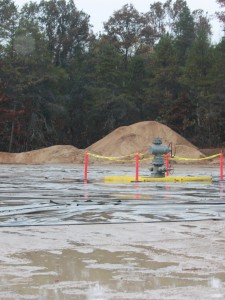
D4-11, October 16. Photo: LuAnne Kozma.
Lighting the heavens
LuAnne Kozma (the director of Ban Michigan Fracking and the Committee to Ban Fracking in Michigan) and I visited the site again on October 6, at twilight. Ensign 161 was lit up. She recorded the sounds and pictures in the video above.
On October 16 we visited the last time. Drilling was complete. The pad was quiet and empty, a gash in the forest with a blowout preventer at the center. No sign displayed the permit number, “conspicuously” or at all.
Ensign 161 had moved a half-mile to the pad of 1-14. It was drilling there in the same Detroit River formation.
The rig is expected back at D4-11 soon, after Marathon runs the numbers. It cost millions to cut the trees, excavate the pad, and bring in the rig. The company won’t want to walk away empty-handed. And next time the bore would not just be vertical. It could be aimed right at Cooley, his nightmare.


